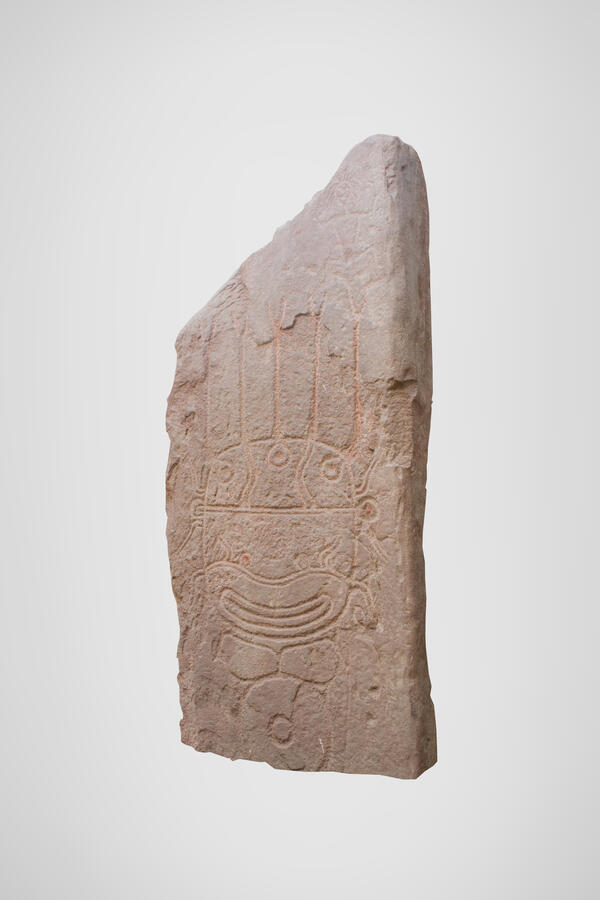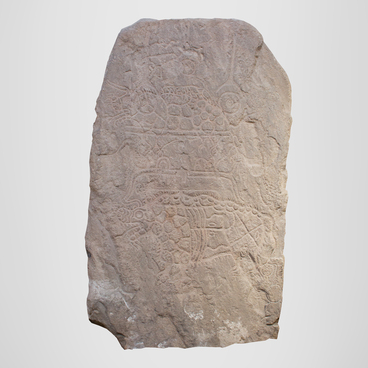On a slab of red sandstone, there is an image of a fantastic face. The stela was found in one of the burial grounds of the Okunev era, the South Siberian archaeological culture of the Bronze Age cattle breeders. This culture dates back to the 2nd millennium BC.
The slab was used as the south wall for a stone burial chamber. The images on it were on the outer side. They are well preserved and clearly visible. The ancient master made the face using the technique of picking: he created indentations along the contour with a sharp instrument, and then polished them.
In the upper right corner there is a full-face female figure in the posture of a woman in labor: her arms are raised up, her legs are bent at the knees and widely spaced. The head is shown schematically, long hair is drawn with rounded lines. In the central part of the slab, you can see the so-called fantastic face, it depicts an ancient deity. In her appearance, the features of a human face are combined with the features of animals. Fantastic elements are also present: for example, five branches are drawn above the mask.
The image of the ancient deity itself is divided into three parts. The upper one is separated by a horizontal line. There are three eyes in its space; the central one is called “frontal”. The bottom of the image is separated from the center by a curved line. The ancient master depicted the nostrils of a fantastic creature in two circles, and the mouth in the form of a narrow oval. On the outside of the mask, on both sides, he also drew two ovals. Short, curved lines extend from them.
In the center above the deity there is a solar sign — a circle, complemented by four symmetrical corners. The embossed lines show traces of the ancient red paint, ochre, in some places. Researchers suggest that in ancient times the mask was entirely painted.
The slab with the image of the face was discovered during archaeological excavations of the Okunev burial ground Verkh-Askiz I, mound No. 1, grave No. 2. Researchers from St. Petersburg carried out the work here. The expedition was led by archaeologist Alexei Kovalev.
The slab was used as the south wall for a stone burial chamber. The images on it were on the outer side. They are well preserved and clearly visible. The ancient master made the face using the technique of picking: he created indentations along the contour with a sharp instrument, and then polished them.
In the upper right corner there is a full-face female figure in the posture of a woman in labor: her arms are raised up, her legs are bent at the knees and widely spaced. The head is shown schematically, long hair is drawn with rounded lines. In the central part of the slab, you can see the so-called fantastic face, it depicts an ancient deity. In her appearance, the features of a human face are combined with the features of animals. Fantastic elements are also present: for example, five branches are drawn above the mask.
The image of the ancient deity itself is divided into three parts. The upper one is separated by a horizontal line. There are three eyes in its space; the central one is called “frontal”. The bottom of the image is separated from the center by a curved line. The ancient master depicted the nostrils of a fantastic creature in two circles, and the mouth in the form of a narrow oval. On the outside of the mask, on both sides, he also drew two ovals. Short, curved lines extend from them.
In the center above the deity there is a solar sign — a circle, complemented by four symmetrical corners. The embossed lines show traces of the ancient red paint, ochre, in some places. Researchers suggest that in ancient times the mask was entirely painted.
The slab with the image of the face was discovered during archaeological excavations of the Okunev burial ground Verkh-Askiz I, mound No. 1, grave No. 2. Researchers from St. Petersburg carried out the work here. The expedition was led by archaeologist Alexei Kovalev.



